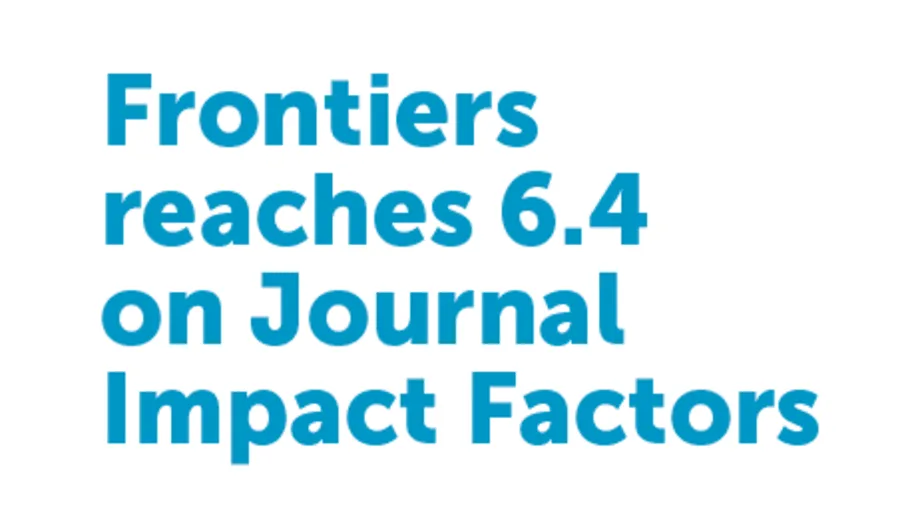
- Science news
- Open science and peer review
- Frontiers tops open-access journal ranking in several JCR categories
Frontiers tops open-access journal ranking in several JCR categories
July 16, 2016: An analysis of open-access journal performance in the 2015 Journal Citation Reports (JCR) revealed that Frontiers journals generated the #1 highest number of citations in the categories of Psychology, Neurosciences, Plant Sciences, Immunology, Neurology and Physiology and the #2 highest number of citations in the categories of Pharmacology & Pharmacy and Microbiology.
Successful open-access journals grow quickly and are sometimes faced with the notion that publishing a large number of papers somehow decreases the overall quality. However, when looking at an analysis for the 19 Frontiers journals currently with impact factors, rankings soar as high as in the 94th percentile and on average were in the 85th percentile out of the 11,365 journals listed in the in the 2015 Journal Citations Reports published by Thomson Reuters in 2016 (See Figure 1).
2015 journal ranking by impact factor (11,365 journals)

Figure 1: The 19 Frontiers journals with impact factors (in red) compared to the other 11,365 journals (subscription and open access) listed in the 2015 Journal Citation Reports. Frontiers ranks in the top 15% of Impact Factors for all journals, with our journals ranking between the 61st to the 94th percentile. The journal analysis is based on the 2015 Journal Citation Reports published by Thomson Reuters, 2016.
The impact factor (IF) is calculated as the average number of citations in a given year to articles published in a journal in the two preceding years (i.e. the 2015 impact factor is based on citations generated in 2015 by articles published in 2013 and 2014 and is published in the summer of 2016). Journals are organized in the Journal Citation Reports within specific categories (e.g. Neurosciences, Physiology, Plant Sciences, etc.) whenever possible and in a Multidisciplinary Sciences category when they publish articles in more than 3-4 disciplines (e.g. Nature, Science, PNAS, PLOS ONE, Scientific Reports, etc.).
Frontiers builds journals around research communities in specific fields and specialties and publishes articles that are scientifically correct and rigorously peer-reviewed. Nineteen of our journals have already passed the rigorous screening Thomson Reuters applies to be indexed and listed in the JCR.
The results of the analysis on impact factor obtained, articles published, and total citations generated were reported in a series of related Frontiers blog posts (see the complete analysis for the 2015 JCR: Neurosciences, Human Neuroscience, Psychology, Plant Science, Microbiology, Immunology, Neurology, Physiology and Pharmacology). The performance of the Frontiers journals was not only stellar when compared to other open access journals, but also against subscription journals, where articles are mostly preselected for impact. Please find our analysis of how Frontiers Impact Factors rise as volume increases: quality at scale here .
2015 open-access journal ranking by impact factor and article numbers

Figure 2**.** Frontiers journals compared to open-access journals in six categories of the latest Journal Citation Reports (2015) published by Thomson Reuters (2016) [3]. In each JCR category, we plot the open-access journals as a function of journal impact factor (x-axis) and article volume (y-axis). Red dots indicate Frontiers journals. Size of the dots is directly proportional to volume of citations in 2015 for articles published in 2013 & 2014. The journal analysis is based on the 2015 Journal Citations Reports published by Thomson Reuters, 2016.
2015 open-access journal ranking by total citations

Figure 3. Most cited open-access journals in six JCR categories where Frontiers journals are listed. Citations in 2015 were counted for articles published in 2013 and 2014. In red are the individual Frontiers journals; in orange is the entire field of Frontiers in Neuroscience; in grey are other open-access journals. The journal analysis is based on the 2015 Journal Citations Reports published by Thomson Reuters, 2016.
Summary of quality and impact analysis 2015
Category of Psychology (19 open access journals, 606 total journals)
In June 2016, Frontiers in Psychology, received the 2015 Impact Factor of 2.463. For two years in a row, it is the largest and the #2 most-cited psychology journal in the world. Read the complete Frontiers in Psychology analysis.
Category of Neurosciences (37 open access journals, 256 total journals)
In the JCR category of Neuroscience, Frontiers has 12 journals listed under the field of Frontiers in Neuroscience. The field of Neuroscience in Frontiers, launched in 2008, has become the #1 most cited and #1 largest open-access publisher in the JCR category of Neuroscience and the 4th most cited and 4th largest Neuroscience publisher overall. Read the complete analysis for Frontiers in the Field of Neuroscience.
The specialty journal, Frontiers in Human Neuroscience, listed in the 2015 JCR categories of Neurosciences and Psychology, has become the **#**1 most cited journal in Psychology, the #1 most cited open-access journal in Neuroscience and the 5th most cited of all journals listed in Neuroscience. It is also the 2nd and the largest open-access journal in all of Psychology and Neuroscience, respectively. Read the complete Frontiers in Human Neuroscience analysis.
Category of Microbiology (20 open access journals, 123 total journals)
In June 2016, Frontiers in Microbiology received the official Impact Factor of 4.165 — up from 3.989 in the previous report. Since its launch in 2010, it has become the 2nd most-cited open-access journal in Microbiology. It is also the largest journal in Microbiology in the world. Read the complete Frontiers in Microbiology analysis.
Category of Pharmacology & Pharmacy (26 open access journals, 253 total journals)
Frontiers in Pharmacology received the 2015 Impact Factor of 4.418 — up from 3.802 in the previous report. Since its launch in 2010, it has become the #2 most cited open-access journal in Pharmacology and Pharmacy. Read the complete Frontiers in Pharmacology analysis.
Category of Plant Sciences (33 open access journals, 204 total journals)
In June 2016, Frontiers in Plant Science, received the official Impact Factor of 4.495 — up from 3.948 in the previous report. Since its launch in 2010, it has become the largest and the most cited open-access journal in Plant Science, and the 5th most cited amongst all journals in Plant Science. Read the complete Frontiers in Plant Science analysis.
Category of Physiology (10 open access journals, 83 total journals)
In June 2016, Frontiers in Physiology, received the official Impact Factor of 4.031 — up from 3.534 in the previous report. Since its launch in 2010, it has become the #1 most cited and 2nd largest open-access journal in Physiology, and the #2 most cited amongst all journals in Physiology. Read the complete Frontiers in Physiology analysis.
Category of Immunology (21 open access journals, 150 total journals)
Frontiers in Immunology, launched in 2010, has just received its first official Impact Factor of 5.695. In just 5 years, it has become the largest and the most cited open-access journal in Immunology, and the 7th most cited amongst all journals in Immunology. Read the complete Frontiers in Immunology analysis.
Category of Neurology (16 open access journals, 192 total journals)
Frontiers in Neurology, launched in 2010, has just received its first official Impact Factor of 3.184. In just 5 years, it has become the most cited and the 3rd largest open-access journal in Neurology. Read the complete Frontiers in Neurology analysis.
Key to success
The results are surprising given that on average a much larger number of papers tended to be published in the Frontiers journals compared to other journals in their category (increasing size is generally believed to lead to a decrease in impact factor) and even more surprising because Frontiers applies an impact-neutral peer-review. This means that we publish all articles that are scientifically correct.
We engineered the Collaborative Peer Review with a review mandate focused on enhancing article quality by means of rigorous and constructive feedback from expert reviewers, quick and direct interactions between authors, reviewers and the editor enabled by our review forum platform, and we enhance transparency by acknowledging reviewers and editors on the published articles. This performance analysis indicates that the impact-neutral Collaborative Peer Review conducted at Frontiers together with an outstanding editorial board has become a powerful model for publishing quality academic papers at scale.
We believe the keys to this success are:
Frontiers impact-neutral peer-review is a rigorous scientific review, of the kind that one gets in specialized journals. The main difference is that reviewers are not asked to predict the significance of the paper.
Frontiers provides an interactive peer-review forum which establishes a direct online discussion between authors, reviewers and editors, which enhances constructive collaboration.
The names of the editor and reviewers are published along with the paper for acknowledgment, accountability and transparency.
Review, Associate and Chief Editors have complete editorial freedom through an online Digital Editorial Office ensuring that Frontiers, as a publisher, does not steer the direction of science.
Editors and reviewers are all external scientists not financially incentivized to accept papers.
Frontiers does not impose or operate according to a rejection rate and rather allows it to be determined by the dynamics of peer-review under complete Editorial Independence.
Frontiers has the largest editorial boards made up of the most cited scientists allowing optimal matching of reviewers to papers – a process managed by an Associate Editor and leading scientists.
Frontiers provides a range of services to enhance discoverability of articles to ensure that each paper gets maximal visibility and the full impact it deserves.
All of this is only possible with a stellar editorial board of researchers (see most recent infographic). Frontiers congratulates all of its Chief Editors the outstanding board of Associate Editors and the diligent work of the Review Editors as well as the Frontiers Journal Management team for this outstanding achievement_._






